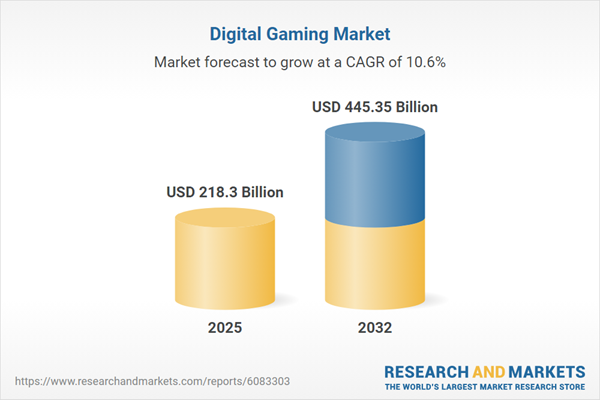Speak directly to the analyst to clarify any post sales queries you may have.
The digital gaming market is experiencing rapid transformation, marked by evolving technologies and consumer behaviors. Industry leaders require clear, actionable insights to refine strategy in this expanding and increasingly complex environment.
Market Snapshot: Digital Gaming Market Growth and Trajectory
The digital gaming market grew from USD 198.42 billion in 2024 to USD 218.30 billion in 2025, continuing on a projected CAGR of 10.63% to reach USD 445.35 billion by 2032. Growth is driven by innovation across cloud gaming, streaming adoption, and immersive platforms, shaping both player experience and industry revenues.
Scope & Segmentation
This report offers a comprehensive analysis of the digital gaming sector’s key segments, regional trends, and technological advancements, enabling stakeholders to capitalize on emerging opportunities. Market segmentation spans platforms, genres, monetization approaches, user demographics, sales channels, and application domains. Covered regions include major developed and emerging markets that collectively shape global demand and supply chains.
- Platforms: Console, Mobile (Android, iOS), PC
- Genres: Action, Adventure, Role-Playing Games (RPG), Simulation, Sports (Racing, Team Sports), Strategy (Real Time, Turn Based)
- Monetization Models: Ad-supported, Freemium, Premium, Subscription-based
- Age Groups: 18-35 Years, Above 35 Years, Below 18 Years
- Sales Channels: Offline, Online
- Applications: Education / Training, Entertainment & Leisure, eSports & Competitive Gaming, Marketing & Brand Engagement, Military & Defense Simulation, Therapy & Rehabilitation
- Regions & Key Countries: Americas (United States, Canada, Mexico, Brazil, Argentina, Chile, Colombia, Peru), Europe, Middle East & Africa (United Kingdom, Germany, France, Russia, Italy, Spain, Netherlands, Sweden, Poland, Switzerland, United Arab Emirates, Saudi Arabia, Qatar, Turkey, Israel, South Africa, Nigeria, Egypt, Kenya), Asia-Pacific (China, India, Japan, Australia, South Korea, Indonesia, Thailand, Malaysia, Singapore, Taiwan)
- Technology Providers & Major Companies: Industry leaders include Microsoft Corporation, Sony Group Corporation, Nintendo Co., Ltd., Electronic Arts Inc., Tencent, NetEase, Epic Games, UBISOFT ENTERTAINMENT S.A., BANDAI NAMCO Holdings, and others.
Key Takeaways for Strategic Decision-Makers
- Cloud gaming, mobile connectivity, and cross-platform interoperability are redefining how players interact across devices, prompting adaptive business models and strategic partnerships.
- Artificial intelligence and machine learning are now integral to game design and operations, powering real-time personalization, moderation, and content delivery to boost user retention and engagement.
- Live service architectures and user-generated content ecosystems have elevated community involvement, extending product lifecycles and enabling flexible monetization strategies.
- Regional market differences require tailored launches, with Asia-Pacific markets prioritizing mobile-first experiences and localized narratives, while Americas and EMEA regions emphasize a blend of premium products and innovative freemium models.
- Investments in infrastructure resilience and efficiency are becoming a competitive imperative, given the dispersed nature of cloud streaming and regulatory nuances in data governance.
- Strategic alliances across content, distribution, and technology verticals enable companies to expand reach and reinforce their differentiated value propositions.
Tariff Impact: Navigating the 2025 U.S. Measures
With new United States tariffs on electronic components and imported gaming peripherals imminent, companies across the supply chain face rising sourcing and production costs. Strategic responses include shifting assembly operations, renegotiating supplier contracts, and localizing data center infrastructure to maintain margins. These adaptive measures influence not only cost structures but also market pricing, service quality, and technology rollouts globally.
Methodology & Data Sources
This research employs a multi-method approach that integrates primary interviews with executives in hardware, software, distribution, and streaming, alongside secondary review of financials, regulatory data, and industry reports. Quantitative analysis of digital storefront transactions and network engagement, combined with scenario modeling and qualitative thematic synthesis, ensures the findings are robust, validated, and actionable for strategic planning.
Why This Report Matters
- Equips leaders with actionable intelligence for strategic investments and risk mitigation in a dynamically evolving digital gaming market.
- Enables benchmarking against competitors, while identifying new avenues for growth, innovation, and expansion in both established and emerging regions.
Conclusion
The digital gaming industry is defined by technological innovation, evolving revenue models, and regional market dynamics. This report provides the strategic clarity required to navigate industry complexity and secure sustainable growth in today’s competitive digital gaming landscape.
Table of Contents
3. Executive Summary
4. Market Overview
7. Cumulative Impact of Artificial Intelligence 2025
Companies Mentioned
The companies profiled in this Digital Gaming market report include:- 7 Raven Studios
- Nanuq Co., Ltd.
- BANDAI NAMCO Holdings Inc.
- CAPCOM Co., Ltd.
- CD Projekt S.A.
- Corecell Technology Co.,Ltd.
- Electronic Arts Inc.
- Epic Games, Inc.
- GungHo Online Entertainment, Inc.
- HUUUGE, Inc.
- KONAMI GROUP CORPORATION
- KRAFTON, Inc.
- Microsoft Corporation
- NCSOFT CORPORATION
- NetEase, Inc.
- Nintendo Co., Ltd.
- Proxima Beta Pte. Ltd.
- Sega Enterprises, Ltd.
- SidePrize LLC
- Sony Group Corporation
- Square Enix Holdings Co., Ltd.
- Take-Two Interactive Software, Inc.
- Tapinator, Inc.
- UBISOFT ENTERTAINMENT S.A.
- Warner Bros. Entertainment Inc.
Table Information
| Report Attribute | Details |
|---|---|
| No. of Pages | 188 |
| Published | November 2025 |
| Forecast Period | 2025 - 2032 |
| Estimated Market Value ( USD | $ 218.3 Billion |
| Forecasted Market Value ( USD | $ 445.35 Billion |
| Compound Annual Growth Rate | 10.6% |
| Regions Covered | Global |
| No. of Companies Mentioned | 26 |









